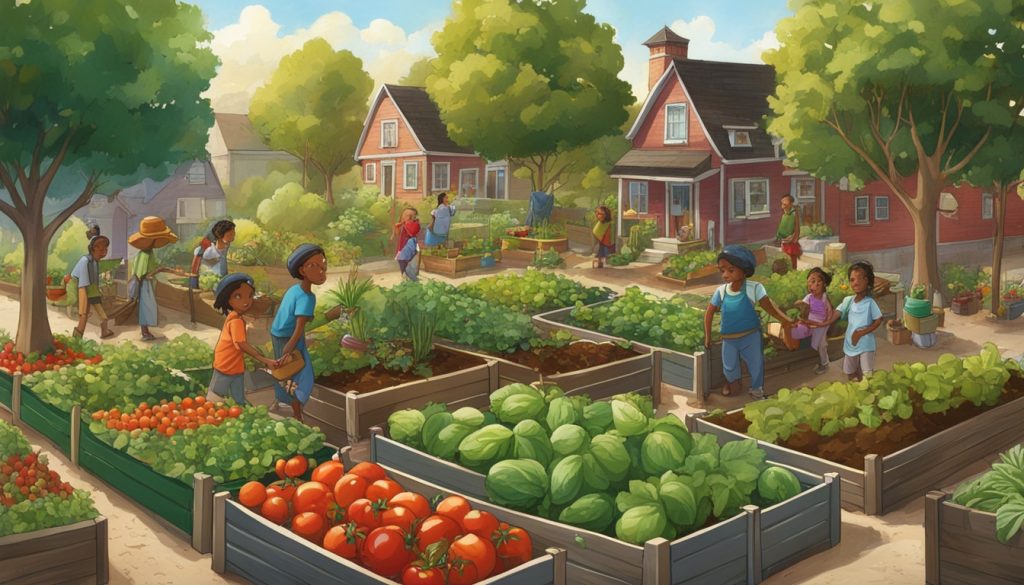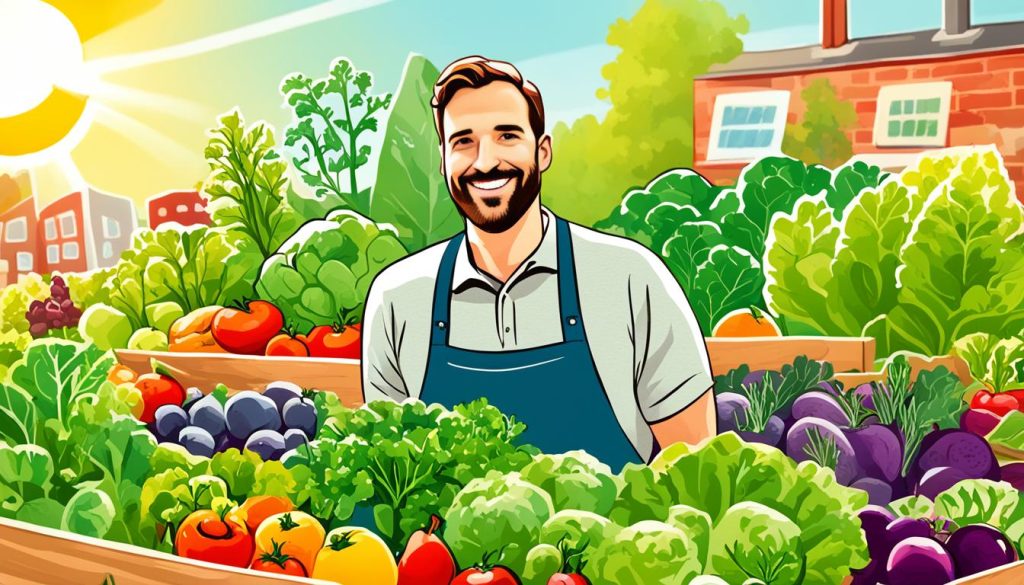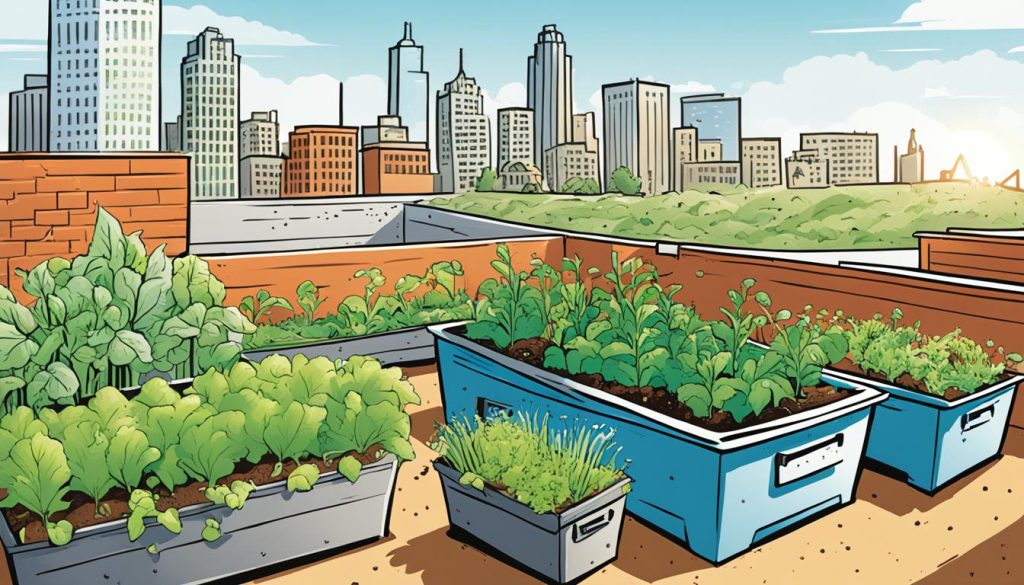Imagine turning your urban space into a lush oasis. It can feed your body and boost your wallet. Welcome to urban farming, where nature helps you grow a sustainable and wealthy future1.
Urban farming brings many benefits. It improves food security, supports local economies, and helps the environment. Even with a small space, you can use smart planting and sustainable methods to increase your wealth and help your community1.
This guide will show you how to start and keep a successful urban farm. You’ll learn how to make money from growing your own food. Discover how urban agriculture can change your community, your finances, and your connection with nature2.
Key Takeaways
- Urban farming can enhance food security, self-sufficiency, and environmental sustainability.
- Innovative farming techniques like vertical farming and hydroponics can maximize limited urban spaces.
- Urban farming provides economic opportunities through surplus produce sales and job creation.
- Community gardens and urban farms can improve neighborhood safety and well-being.
- Integrating urban farming into architectural design offers creative and sustainable solutions.
The Benefits of Urban Farming
Urban farming has become more popular as people worry about food security and sustainability3. By growing their own food, city farmers can be more self-sufficient and cut down on their food chain reliance. This boosts personal food security and helps the community as a whole3.
Urban farming also has big environmental perks3. It can lower energy use and emissions from food transport3. Plus, it creates homes for pollinators like birds, bees, and butterflies3. These benefits make cities more sustainable and resilient.
Food Security and Self-Sufficiency
Urban farming makes cities more food secure and self-sufficient3. It can supply a lot of fresh produce, meeting up to 31% of veggies and 17% of fruits3. In Cleveland, it could cover 46% to 100% of fresh produce, 94% of poultry, and 100% of honey3.
Environmental Benefits of Growing Your Own Food
Urban farming is good for the planet too3. It cuts down on the carbon emissions from food transport3. Farms like Clay Bottom and Gotham Greens show it can be profitable and efficient3.
Turning empty lots into farms saves cities money and can raise property values nearby3. This approach helps growers and makes cities better for everyone.
Urban farming does more than just help individuals grow their own food3. It boosts food security, supports the environment, and builds community strength. It’s a key way to make cities better and more self-sufficient3.
Getting Started with Urban Farming
Starting an urban farm means looking at your space and how much sun it gets. Before you start, think about what your city space is like4. Cities have unused areas like empty lots, rooftops, and vacant land that can be used for farming4. Knowing how the sun shines on your spot helps you make good choices for your farm.
Assessing Your Space and Sun Exposure
Urban farming isn’t one-size-fits-all. The space and sunlight in your area affect what you can grow and how you’ll do it4. You can grow food in the ground, use hydroponics, or even produce food underground4. Watch how the sun moves over your area all year. Most veggies need 6-8 hours of direct sunlight daily4. This helps you pick the best spots for your farm.
Building Healthy Soil and Compost
Good soil is key for a successful urban farm. There are four main types of urban farms: Community Gardens, Farms, Commercial Farms, and Institutional Gardens5. In cities, soil quality can be poor, so you might need more fertilizer5. To fix this, use compost to make your soil rich4. Using city waste can cut costs and help the environment5. Making your own compost boosts soil health and cuts down on outside inputs, making your farm better for the planet.
Starting your urban farm journey? Begin small, watch your space, and focus on healthy soil. With good planning and hard work, you’ll grow a successful farm that feeds your community6. Urban farms are important for making food and sometimes even extra money645.
Planning Your Urban Farm
When planning your urban farm, picking plants that fit your local climate is crucial. Urban areas often have unpredictable weather, so choosing the right plants is key for a good harvest7.
Using perennial crops and plants that do more than one thing can make your farm work better. Perennials like fruit trees and herbs need less care each year. They give you food reliably8. Plants like sweet potatoes do many jobs, including feeding you, covering the ground, and even feeding animals, making your space efficient9.
Choosing Climate-Appropriate Plants
Choosing plants that fit your local climate is a top priority for your urban farm. This helps them grow well despite the challenges of city life, like little space and unpredictable weather. By picking the right plants, you boost your chances of a great harvest7.
Incorporating Perennials and Multifunctional Plants
Adding perennials and plants that do more than one thing to your farm makes it better and greener. Perennials like fruit trees and herbs are easy to care for and give you food year after year8. Plants like sweet potatoes help in many ways, using your space wisely9.
“Due to the harsh weather patterns we can experience here in Qld, I have been very selective with what I plant. All of our plants are suited to the Subtropical climate and most are perennial, meaning we get more bang for our buck.”
Plan your urban farm with plants that fit your climate, last a long time, and do more than one thing. This way, you get a lot from your space and help your farm be sustainable. It leads to a lot of food and makes your farm self-sufficient789.
The Financial Impact of Urban Farming: Growing Your Own Wealth
Urban farming brings big financial benefits for people and communities. By growing your own food, you can cut down on grocery bills. You might even make extra money by selling your extra produce to local chefs or at farmer’s markets10. Being part of home or community gardens can help you save money and get access to foods that are hard to afford10.
Urban farming does more than just save you money. It helps the local economy by supporting food systems and creating jobs for city farmers10. It also makes neighborhoods prouder and brings people closer together10. Plus, it’s a reliable way to get local food when big food chains fail10.
Now, governments are seeing the value in urban farming too. The USDA has put over $1 billion into local food systems, including urban farming, from 2009 to 201511. In 2020, they gave $4 million to urban farms, with $3 million to fight food insecurity and $1 million for composting to cut down on food waste12.
Urban agriculture mainly benefits with fruits and veggies, but its effects spread wide11. Farms can make money through tours, events, and talks on sustainable food production12. They do better when they get outside help or sell more food12.
As more people and communities get into urban farming, its financial benefits keep growing. By using your small space wisely, you can make a profit and help your community’s economy10.
“Urban agriculture aims to reduce household food expenses through food production, create jobs, and improve property values.”11
Sustainable Practices for Urban Farming
Starting your urban farming journey means focusing on sustainable practices for long-term success. At the core is integrated pest management. This method aims to balance your garden’s ecosystem13.
Planting a mix of perennial flowers and bushes is a smart move. It makes your garden look great and helps pests’ natural enemies, like praying mantises, control pests13.
Integrated Pest Management
Using integrated pest management cuts down on harmful chemicals. It helps create a biodiverse garden. This fits well with sustainable urban farming, aiming for less environmental impact and more garden productivity13.
Closing the Loop: Chickens, Compost, and Cycles
“Closing the loop” is a big part of sustainable urban farming. It means using chickens, compost, and nutrient cycling for a self-sustaining garden134.
Chickens can help by eating pests and making nutrient-rich manure. This manure can then be composted and used to feed your garden13.
This cycle reduces waste and enriches the soil. It’s a cycle of growth and renewal134.
“The chickens helped complete our little ecosystem. We saw results right away as they eliminated our grub problem by feasting on the juicy beetles in our yard.”
By adopting these sustainable methods, you can make your urban farm both productive and eco-friendly. It helps your community become more resilient and healthy13144.
Maximizing Your Harvest
To make the most of your urban farm, you should extend the growing season and store your harvest well. By using smart strategies, you can have fresh, healthy food all year and make more money from your farm15.
Extending the Growing Season
Using a polytunnel greenhouse is a great way to grow more plants and keep them safe from the weather. It lets you grow a wider variety of plants and keep harvesting longer15. You can also save space with vertical growing systems like stacked planters or hydroponic towers. These can greatly increase how much you can grow in a small area16.
Storing and Preserving Your Bounty
Storing and preserving your farm’s produce is key to getting the most value from it. Curing garlic and keeping leafy greens like lettuce in the fridge can make them last longer. This way, you can enjoy these healthy foods all year15. You can also dry, can, or freeze extra produce to keep your homegrown food coming all year16.
| Crop | Storage Technique | Shelf Life |
|---|---|---|
| Garlic | Curing | 6-12 months |
| Lettuce | Refrigeration | 1-2 weeks |
| Tomatoes | Canning | 1-2 years |
| Berries | Freezing | 6-12 months |
By using these methods to extend the growing season and preserve your farm’s produce, you can boost both the financial and nutritional value of your homegrown food15. The secret to a successful urban farm is using every bit of space wisely and keeping a steady supply of fresh, healthy food16.
Conclusion
Urban farming brings many benefits, like more food security and better health. It also helps the environment and can make money. Plus, it strengthens communities17.
People who eat fresh produce from their area tend to eat healthier and get fewer diet-related illnesses17. Urban farms can help families meet up to 30 to 40 percent of their produce needs17. Farms that handle packaging and processing create many jobs17.
These projects focus on teaching new skills and jobs to the community17. They save families money by providing most of their food17. Urban farms also make safe, inviting places for people to meet and play17.
They offer workshops, gardening classes, and food prep sessions17. This helps build a strong community and makes neighborhoods safer17.
By following the steps in this article, you can turn your space into a productive farm18. Urban farms can raise property values and improve social connections among neighbors18. They help bring different groups together, reducing tensions and promoting social integration18.
Some farms also offer education, youth programs, and training for jobs18.
Whether you’re starting or expanding your garden, the first step is to begin and learn19. Urban farming creates jobs in cities worldwide, offering direct and indirect work19. It makes fresh produce more available to city folks who might not have easy access to grocery stores19.
It also cuts down on the need for long-distance food transport, saving money and the planet19. The author says, “If you’ve thought about growing your own food, just start now. You don’t need much land to grow a lot of food, and there’s nothing better than eating from your own yard.”
FAQ
What are the financial benefits of urban farming?
What are the environmental benefits of urban farming?
How do I get started with urban farming?
What are some tips for maximizing the productivity of my urban farm?
How can I extend the growing season and preserve my urban farm’s harvest?
Source Links
- All You Need to Know about Urban Farming.
- 29 Surprising Benefits Of Urban Farming
- Plants and Policies: How Urban Farming is Transforming Cities | AU Online
- Urban Farms and Their Benefits: Producing Food in the City
- Scaling Urban Agriculture to Bring Many Benefits
- Introduction | University of Maryland Extension
- Urban farms save money and battle food insecurity
- Chapter 4: Managing legal risks to grow your urban farm
- AskJudgeMathis.com | Urban Farming for Profit
- FCS3378/FY1517: Social and Community Benefits and Limitations of Urban Agriculture
- The Role of Urban Agriculture in a Secure, Healthy, and Sustainable Food System
- The Economic Viability of Urban Farming
- Urban Farming and Sustainability — Sustainable Review
- A review on urban agriculture: technology, socio-economy, and policy
- Backyard Farming Ideas for Aspiring Urban Growers
- Urban Farming Ultimate Guide and Examples | GroCycle
- The real value of urban farming. (Hint: It’s not always the food.)
- The Economic Impact of Urban Farming Businesses on Local Economies – FasterCapital



